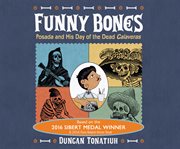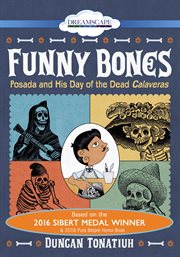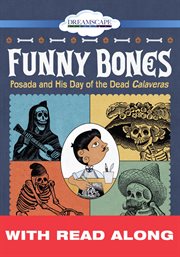Review by Booklist Review
*Starred Review* This exceptional picture-book biography profiles Mexican artist José Guadalupe Posada (1852-1913), who is remembered primarily for his portrayal of calaveras, the droll skeletons prominent in Día de Muertos (Day of the Dead) celebrations. Posada, who loved to draw as a child, later discovered printmaking, the art form that would shape his career. He learned lithography, engraving, and etching, three techniques that are succinctly explained here and illustrated through cartoonlike panels of drawings. As an adult, then known as Don Lupe, Posada's images of calaveras amused the public by poking fun at politicians. In the second half of the book, every other page reproduces a Posada print and asks a question, such as, Was Don Lupe saying that . . . even powerful leaders one day become calaveras? The use of questions works well, encouraging readers to engage with the art, while the clearly written narrative continues on the facing pages. Appearing throughout the book, Tonatiuh's illustrations are digital collages notable for their controlled energy, vibrant colors, and a wonderfully rhythmic arrangement of forms on the page. The final scene, a witty, updated version of grinning calaveras, depicts them as young people today. Playful but informative, this picture book offers a fascinating introduction to the artist and his work.--Phelan, Carolyn Copyright 2015 Booklist
From Booklist, Copyright (c) American Library Association. Used with permission.
Review by Publisher's Weekly Review
Tonatiuh offers a comprehensive look at the life of Mexican artist and printmaker José Guadalupe "Lupe" Posada, while providing a crash course in lithography, engraving, etching, and studying art. Posada is best known for his calavera images (featuring the skeletons associated with Mexico's Day of the Dead), which Tonatiuh intermixes with his own brand of hieroglyphic digital collages. Reproductions of Posada's calavera images accompany questions that encourage readers to consider their meaning ("Was Don Lupe saying that... no matter how fancy your clothes are on the outside, on the inside we are all the same?"). With a wealth of biographical and contextual information (much of it in an extensive author's note), it's a valuable introduction to Posada that will leave readers thinking about the process of creating art and the social impact it can have. Ages 6-10. (Aug.) © Copyright PWxyz, LLC. All rights reserved.
(c) Copyright PWxyz, LLC. All rights reserved
Review by School Library Journal Review
Gr 3-6-Tonatiuh's latest delves into the life of artist and social commentator extraordinaire José Guadalupe Posada, best known for his literary calaveras, brief and amusing rhyming poems about skeletons dressed in clothes, going about their daily business. The beautifully expressive Day of the Dead-inspired illustrations on heavy paper pages sport borders of bones, grinning skeletons, and Tonatiuh's signature figures shown in profile, influenced by the ancient Mexican art of his ancestors. Simple yet effective sentences accompany step-by-step images detailing the artistic processes that Posada learned as a printer's apprentice: lithography, engraving, and etching. Reproductions of Posada's calaveras will help children appreciate Posada's passion for his profession, such as the broadside "Calavera Love," which depicts a gentleman skeleton proposing marriage; the poem concludes, "I am sorry, Señor. But that cannot be./You're handsome and all,/but too skinny for me!" Tonatiuh explains the poetry, posing questions about the artist's intentions and adding historical context, explaining the calaveras that Posada created in response to the Mexican Revolution. Extensive back matter includes links where students can see Posada's original work and an author's note that suggests using the calaveras "to learn and celebrate el Dia de Muertos." VERDICT A stunning work, with great possibilities for lesson plans or tie-ins with Day of the Dead.-Toby Rajput, National Louis University, Skokie, IL © Copyright 2015. Library Journals LLC, a wholly owned subsidiary of Media Source, Inc. No redistribution permitted.
(c) Copyright Library Journals LLC, a wholly owned subsidiary of Media Source, Inc. No redistribution permitted.
Review by Horn Book Review
Artist Jos Guadalupe Posada (18521915) didnt invent calaveras, the iconic skeletons associated with Mexicos Day of the Dead celebration, but they attained their greatest popularity during the twenty-four years that he drew them. Posada died poor and relatively unknown, but interest in his work grew steadily after his death, and now Tonatiuh brings his story to a child audience. In his signature flat illustrative style reminiscent of the Mixtec (an indigenous Mesoamerican people) codex, Tonatiuh digitally layers various colors and textures onto simple, black-outlined line drawings. Appropriately, Posadas own artwork also plays a prominent role in the book and provides a nice complement to Tonatiuhs illustrations, especially in a series of broadsides that ask the reader to consider the relationship between art and politics in Mexican culture. The straightforward narrative incorporates biographical highlights and personal anecdotes, while extended sidebars illustrate the different processes of lithography, engraving, and etching (one of which contains a small error). An authors note, glossary, bibliography, and index round out the full assort-ment of nonfiction features, making this book a worthy successor to Tonatiuhs 2015 Belpr and Sibert honorwinning Separate Is Never Equal (rev. 7/14). jonathan hunt(c) Copyright 2015. The Horn Book, Inc., a wholly owned subsidiary of Media Source, Inc. No redistribution permitted.
(c) Copyright The Horn Book, Inc., a wholly owned subsidiary of Media Source, Inc. No redistribution permitted.
Review by Kirkus Book Review
Tonatiuh's Mixtec-influenced illustrations make an apt complement to this picture-book biography of one of Mexico's most beloved artists, Jos Guadalupe Posada. Don Lupe, as he was called, used the printing techniques of lithography, engraving, and etching. Each technique is summarized in four-panel layouts, and sample images of his calaveras and calacas (skulls and skeletons) are liberally incorporated into the illustrations. Many of the iconic images associated with Da de los Muertos were created by Posada as integral elements of his world-renowned political satire, particularly during the Mexican Revolution. Tonatiuh skillfully blends his own distinctive style of digital collage and hand drawings not only to highlight events in Posada's life, but also to add whimsical elements by introducing contemporary calaveras. He incorporates amusing, thoughtful exercises for young readers into the narrative, prompting them to interpret the messages behind Posada's artwork. Also included is an in-depth author's note on the history of the Day of the Dead and an extensive glossary. In addition, a bibliography, list of art credits, and venues where Posada's art is displayed are provided for further exploration of Posada's life and work. Phonetic pronunciation is, unfortunately, only sporadically and unevenly sprinkled throughout the story. Following on his Sibert Honor-winning Separate Is Never Equal (2014), Tonatiuh further marks himself as a major nonfiction talent with this artistically beautiful and factually accessible offering that effectively blends artistic and political content for young readers. (Picture book/biography. 7-13) Copyright Kirkus Reviews, used with permission.
Copyright (c) Kirkus Reviews, used with permission.



